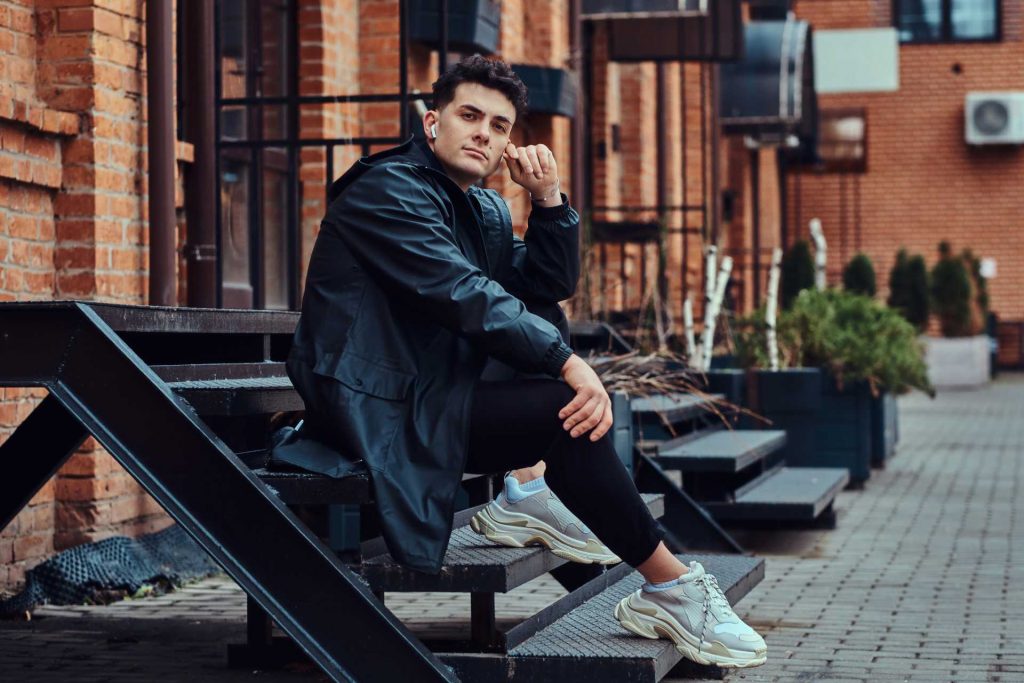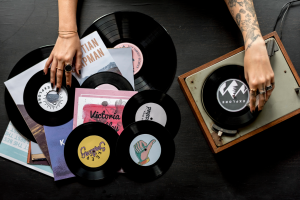The indelible intersection of fashion and music has long been a dynamic force that shapes cultural trends worldwide. This fascinating interplay is not just about aesthetics, but also serves as a powerful form of self-expression that reflects the spirit of the times. From the iconic suits of The Beatles in the ’60s to the flamboyant stage outfits of Lady Gaga, musicians have consistently used fashion as a medium to communicate their identities and ideologies. Likewise, fashion designers often draw inspiration from the music scene, creating styles that resonate with the fans and echo the rhythm of their favorite tracks. This symbiotic relationship creates a vibrant cycle of influence, where music impacts fashion and vice versa. In this blog post, we delve into the intricate dance between these two cultural phenomena, exploring their historical interconnections, current trends, and the social implications of their convergence. We will also examine specific case studies and analyze the impact of music festivals and designer-musician collaborations on the fashion industry. Let’s embark on this stylish symphony where beats meet seams, and melodies intertwine with silhouettes.
Historical Overview
The interplay between music and fashion has a rich history, dating back to the early 20th century. Jazz musicians in the 1920s and ’30s, with their sharp suits and fedoras, set the sartorial tone for an entire generation. This was not merely about looking good; their attire was a statement of rebellion against societal norms, much like the music they played.
The 1950s saw the advent of rock ‘n’ roll, and with it, a new fashion movement. Artists like Elvis Presley popularized the rebellious leather jacket and jeans look, which became synonymous with the genre. The ’60s and ’70s brought in a wave of countercultural movements – the hippies, with their flower power aesthetics and the punks with their distressed denims and band tees. These styles were reflective of the music of the time, serving as an outward expression of the cultural zeitgeist.
As we moved into the ’80s and ’90s, pop and hip-hop took center stage. Pop icons like Madonna pushed boundaries with her provocative outfits, while hip-hop artists like Run DMC made Adidas sneakers and tracksuits a staple. Today, the relationship between music and fashion continues to evolve, with artists and designers collaborating more closely than ever, influencing trends and shaping our culture in real-time.
Analysis of Current Trends
In the current music and fashion landscape, the line between artist and designer is increasingly blurred. Musicians are not only influencing fashion; they are actively shaping it.
A key trend is the rise of streetwear, largely driven by the popularity of hip-hop and electronic music. Artists like Travis Scott and Billie Eilish have made oversized hoodies, cargo pants, and chunky sneakers mainstream. Their unique style reflects a shift towards comfort and individuality in fashion.
Another trend is the influence of K-Pop on global fashion. Bands like BTS and Blackpink have become fashion icons, with their eclectic mix of high fashion and streetwear, often combined in unexpected ways. Their influence extends beyond their massive fanbase, with designers and fashion houses taking note.
Gender-fluid fashion is another significant trend, with artists like Harry Styles and Janelle Monáe blurring the lines between traditionally male and female clothing. This trend mirrors a broader societal shift towards breaking down gender norms.
Lastly, we see an increasing number of musicians launching their own fashion lines. Rihanna’s Fenty, Kanye West’s Yeezy, and Pharrell Williams’ Human Race are prime examples. These artists are not just endorsing products; they are creating them, marking a new era in the relationship between music and fashion.
Case Studies
Case Study 1: Beyoncé and Ivy Park
Beyoncé’s athleisure brand, Ivy Park, is a prime example of a musician successfully venturing into the fashion world. Launched in 2016, Ivy Park blends high-performance sportswear with streetwear aesthetics, reflecting Beyoncé’s personal style and ethos. The brand has seen immense success, thanks to its inclusive sizing, empowering messaging, and Beyoncé’s star power.
Case Study 2: BTS and Gucci
Korean boyband BTS has had a significant impact on fashion, particularly through their association with Gucci. Their daring, eclectic fashion choices, often featuring Gucci pieces, have made them global style icons. The band’s influence is so strong that items they wear often sell out instantly, a phenomenon known as the “BTS effect”.
Case Study 3: Billie Eilish and Sustainability in Fashion
Billie Eilish uses her platform to promote sustainability in fashion. Known for her oversized, gender-neutral outfits, Eilish often wears sustainable brands, vintage pieces, or clothes she’s designed herself. She’s vocal about the climate crisis and the fashion industry’s role in it, influencing her fans to be more conscious consumers.
These case studies illustrate how musicians are leveraging their influence to shape fashion trends, promote causes they care about, and even build successful fashion businesses.
The Role of Music Festivals in Fashion
Music festivals have become significant cultural events that extend beyond music, playing a pivotal role in shaping and propelling fashion trends. They serve as a platform where music, fashion, and personal expression intersect.
One of the most influential music festivals is Coachella, held annually in California. With its blend of top-tier performers and celebrity attendees, it has become a global style hotspot. The ‘Coachella look’—bohemian, carefree, and often extravagant—has influenced high street and luxury fashion alike. Brands release ‘festival collections’, and ‘festival fashion’ has become a genre of its own.
In the UK, Glastonbury Festival has a more grunge, utilitarian vibe, with wellies and raincoats being staple items due to the unpredictable British weather. It fosters a more laid-back, alternative style, influencing trends like the revival of the 90s bucket hat or the popularity of the Barbour jacket.
Furthermore, festivals like Afropunk celebrate cultural heritage through fashion, showcasing Afrocentric aesthetics and promoting Black designers.
Social media amplifies the impact of these festivals. Attendees share their outfits on platforms like Instagram, inspiring their followers and making these festivals global trendsetters. In essence, music festivals have become runways, where new fashion trends are born and propagated.
The Business Side: Fashion Collabs with Musicians
On the business side, collaborations between fashion brands and musicians have become a highly effective strategy. These partnerships leverage the musician’s fan base, infuse the brand with a dose of cultural relevance, and often result in lucrative sales.
Rapper Travis Scott’s collaborations with Nike have been incredibly successful. Every shoe release causes a frenzy, with pairs selling out in minutes and reselling for multiples of their original price. Scott’s unique aesthetic and massive fan base make him a valuable partner for Nike.
On the luxury end, pop star Rihanna’s partnership with LVMH to create the Fenty fashion house marked a historic moment: she became the first black woman to lead a luxury maison. Although the clothing line was closed in 2021, the Fenty Beauty and Fenty Skin lines continue to thrive.
These collaborations show how the synergy between music and fashion can result in substantial commercial success, benefitting both the artist and the brand.
The Social Impact of the Intersection of Fashion and Music
Music and fashion have always been powerful tools for self-expression and identity formation, and their intersection has significant social impact. They often reflect the zeitgeist, echoing societal changes, cultural shifts, and political movements.
For instance, in the 1960s and 70s, the counterculture movement used both music and fashion as forms of protest. Musicians like Jimi Hendrix and Janis Joplin wore psychedelic prints and flared jeans, symbols of rebellion against mainstream norms. Their styles were emulated by their fans, spreading the counterculture ethos.
In more recent years, musicians have used fashion to challenge gender norms and promote inclusivity. Artists like Janelle Monáe, Harry Styles, and Billie Eilish are known for their androgynous style, breaking away from traditional gendered clothing. This visibility helps to normalize gender fluidity and promotes acceptance of diverse identities.
Moreover, musicians often use their platforms to advocate for ethical fashion. Artists like Stella McCartney and Pharrell Williams have collaborated with brands to create sustainable collections, raising awareness about the environmental impact of the fashion industry.
In these ways, the blend of music and fashion can be a powerful force for social change, influencing attitudes and sparking conversations on important issues.
To Sum It Up
In conclusion, the intersection of music and fashion is a dynamic and influential phenomenon that transcends aesthetics and commercial success. It serves as a mirror to society, reflecting and shaping cultural trends, societal shifts, and individual identities.
Music festivals have evolved into significant cultural events that do more than showcase musical talent; they are platforms for self-expression and are instrumental in propelling fashion trends globally. Meanwhile, collaborations between musicians and fashion brands have proven to be a successful business strategy, leveraging the musician’s cultural influence and fan base to drive sales and elevate brand relevance.
But perhaps most importantly, the fusion of music and fashion has substantial social impact. It can serve as a vehicle for protest, challenge societal norms, promote inclusivity, and advocate for sustainability. Artists use their platforms to express their identities, share their values, and influence their fans, driving societal change through their sartorial choices.
As we continue into the 21st century, the symbiotic relationship between music and fashion will undoubtedly persist. This alliance will continue to shape our cultural landscape, reflect our societal attitudes, and offer compelling insights into the spirit of our times.



